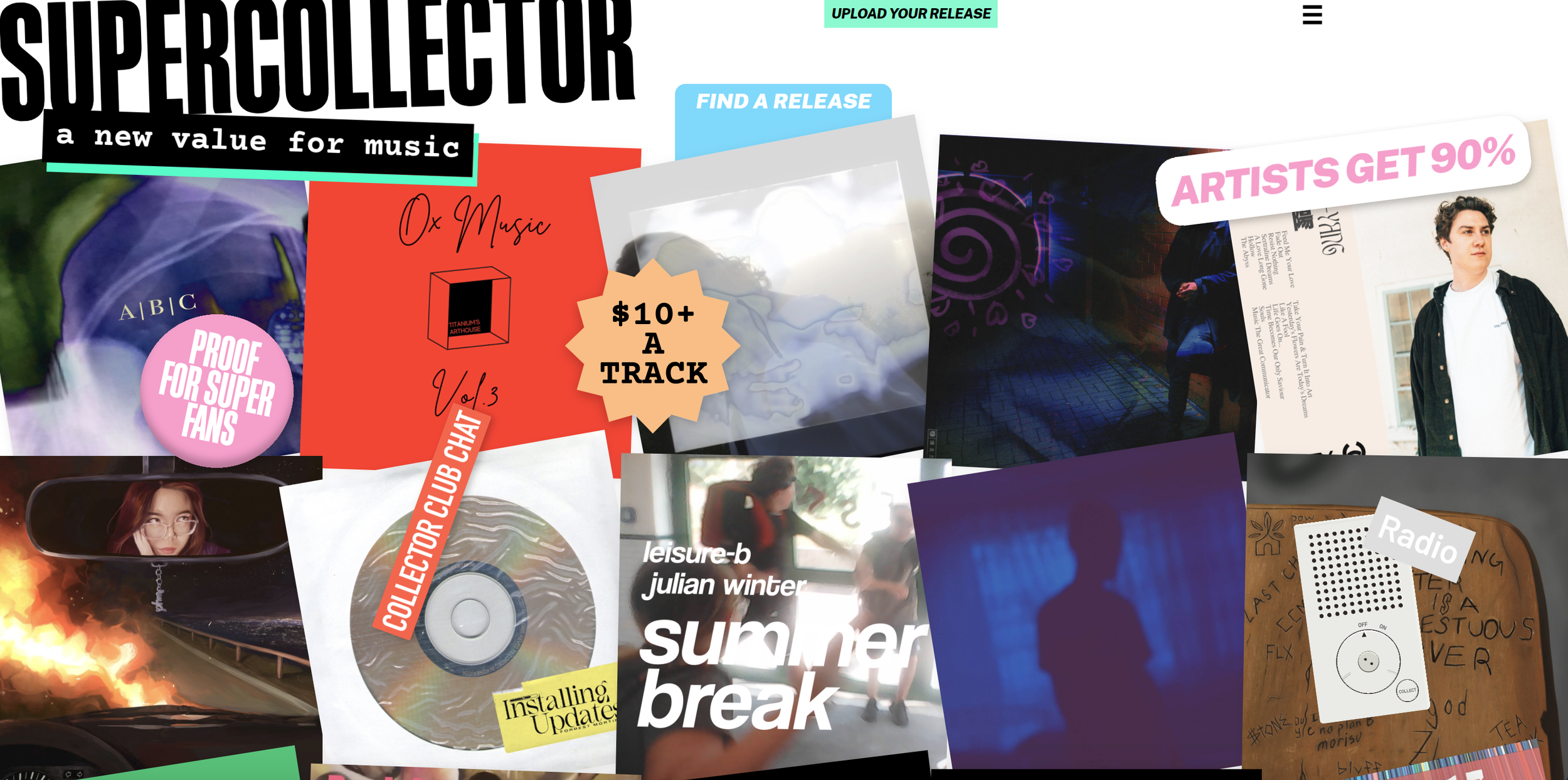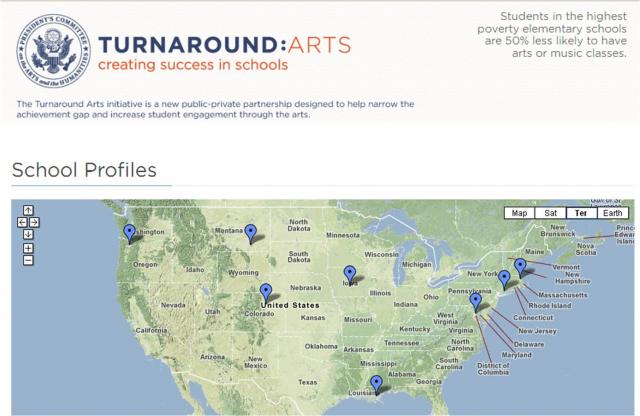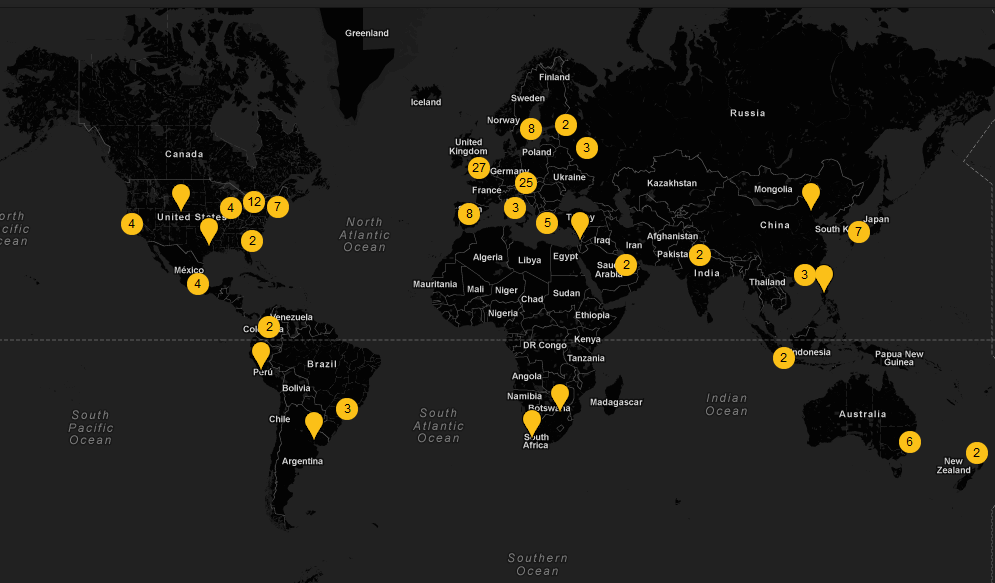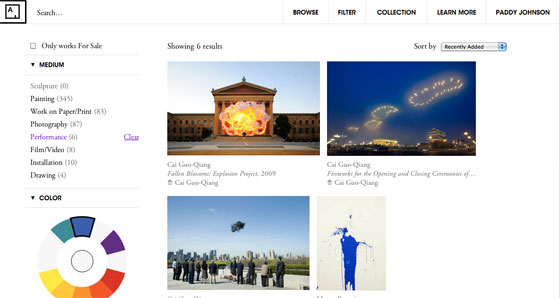The Australian Chamber Orchestra (ACO) has teamed up with Sydney digital media company Mod Productions to produce a new interactive “virtual orchestra” that is breaking down audience barriers in the music world. The resulting audio-visual installation, “ACO Virtual,” has created the means to bring the Orchestra outside the concert hall and into spaces where the ACO may not perform.
Mapping Social Networks -- Present, Past, Future
Mapping and networks feel modern and hip. In today's increasingly connected world, we assume that social networks are real-time, technologically relevant, but networks of influence far precede our internet-focused era. Significantly, mapping networks offers an understanding of how ideas travel. Visual and performing art historians, professional dramaturgs and curators all know that mapping people, objects, or ideas across time and space can broaden an understanding of an art piece or process. Administrators can also benefit from studying networks.
50 quick resources online for arts managers engaged in arts education
Lisa Cheeses’ exploration of 50 approaches to arts integration offers arts educators a fresh perspective to examine their lesson plans. In addition to arousing children’s interests in art, arts education is playing a more powerful role of inspiring children to learn the world in creative ways, ways they like. This article inspires arts managers and arts education to rethink arts education from an integration perspective: why not add mathematical or scientific elements to the arts education programs?
Bringing Art and Discussion to a Computer Near You: Introducing Google Art Talks on Google+
I am mildly obsessed with Google Cultural Institute. Why, you ask? It's two-fold. Firstly, Google has implemented its newest project to supplement the Google Art Project, Google Art Talks on Google+. As published on Google's Official Blog, "Each month, curators, museum directors, historians and educators from some of the world’s most renowned cultural institutions will reveal the hidden stories behind particular works, examine the curation process and provide insights into particular masterpieces or artists."
All You Need Is #TechLove
Valentine's Day might have been invented by greeting card companies, but we don't mind! We've compiled a list of our favorite apps and even got some of our followers to chime in. We got all sorts of suggestions from Twitter from our friends using #techlove. Here's the technology we'd like to send some valentines to:
Jon Schwartz & The Kids Like Blues Band Program: How technology and music help children learn
“We’ve managed to incorporate tons of technology into our classroom. Over 90 % of my students have personal blogs. Through their individual blogs, the kids can keep their parents in the loop and show off their creative skills. I get instant email updates when they blog, and nothing is cooler than seeing one of my students post to their blog – over the weekend!- about guitars they wish they had! Oh how I can relate!”
------Jon Schwartz
Can you believe a six-year-old child is as proficient as you do in Photoshop and blogging? Yes! That is what’s happening at Garrison Elementary School located in Oceanside, California. Jon Schwartz, a blues guitarist and a second grade teacher, creatively uses the blues, blogs and Photoshop, as tools to educate kids. Jon’s teaching endeavors, creativity and energy seem highly relevant to arts engagement opportunities for organizations across the country.
The Kids Like Blues Band Program is about using blues music and lyrics as a springboard for teaching academic content standards in reading, writing, listening, speech, social studies, and the visual and performing arts. Based on a careful song selection, Jon chooses lyrics with the appropriate cadence, imagery, and kid-friendly content. Students then sing out the vocabulary given the rhythm, and in turn practice reading through repetitive and engaging activities. The kids themselves are encouraged to choreograph cool dance moves and motions to help them define and recall complicated vocabulary.
These activities provide children an encouraging and exciting environment that motivates them to learn new knowledge and unleash their creativities. Chuck Berry’s “Let it Rock” is one of the most popular tunes.
[embed width="560" height="315"]http://youtu.be/Nlg5n9GmpZE[/embed]
Students who are learning English, have speech difficulties or other learning disabilities, and just plain shy kids seem to develop more confidence as they learn the songs since the material presented to them is an engaging group practice, rather than them needing to talk by themselves in front of the whole class.
See how a Japanese girl benefits from the project:
[embed width="560" height="315"]http://youtu.be/8hCWFIPmD5Q[/embed]
Additionally, both high achieving and struggling students who have made tremendous gains tend to take leadership roles in their enthusiasm generating creative opportunities, such as designing dance moves, coaching others, blogging the artworks.
See how children create artworks through Photoshop and Blogging:
[embed width="560" height="315"]http://youtu.be/xt4AZ5XWQsM[/embed]
“Perhaps most importantly, my students’ self esteem is soaring and they are becoming passionate about lessons that would have otherwise been dull..”said Mr. Schwartz. These strong emotional responses to the arts are exactly what arts educators wants to generate in the children, what arts organizations want to generate in their audience, and what art wants to generate in the human soul. Mr. Schwartz’s model of creative participation and engagement can be translated to audience engagement models through online groups or onsite post-experience workshops. The opportunities abound for the arts to become as exciting to your audience as they are to these students.
Resource:
You will see all of the articles, TV features and 4 videos on their official website www.kidslikeblues.org
What a Difference an “A” Makes: Moving from STEM to STEAM
It’s a hot-topic today, complete with nifty acronyms, but the great debate about the “Two Cultures” is hardly a new one. The movement to  incorporate “Art” in the STEM (Science, Technology, Engineering, and Mathematics) program curriculum recalls the historic debate between the Sciences and the Arts (for more information on the debate, read C.P Snow's short essay, "The Two Cultures”). The irony of their supposed polarity is the fact they are completely interrelated. To say that the field of Engineering involves and is influenced by nothing more than “scientific” fundamentals is to say a peanut butter and jelly sandwich is made with nothing more than peanut butter. And we all know that is just plain silly, and only half the sandwich.
incorporate “Art” in the STEM (Science, Technology, Engineering, and Mathematics) program curriculum recalls the historic debate between the Sciences and the Arts (for more information on the debate, read C.P Snow's short essay, "The Two Cultures”). The irony of their supposed polarity is the fact they are completely interrelated. To say that the field of Engineering involves and is influenced by nothing more than “scientific” fundamentals is to say a peanut butter and jelly sandwich is made with nothing more than peanut butter. And we all know that is just plain silly, and only half the sandwich.
“The arts can no longer be treated as frill. Arts education is essential to stimulating the creativity and innovation that will prove critical to young Americans competing in a global economy.”- U.S Secretary of Education, Arne Duncan
Ask an engineer (go ahead, I did) if they have ever turned to creative problem solving in their work, prototype building, model-making, or taken a course in design as part of their program’s curriculum. A course in design teaches an engineer the artistic and creative fundamentals they then apply to engineering-specific projects and solutions. Need a second opinion? Ask the Chief Financial Officer (CFO) at any company if they have ever pulled out a dry-ease marker and taken it to the white-board to diagram the effects of a potentially risky investment or visualize projections for the next quarter. Visual studies and applications are an integral component of STEM professions.
“The idea that we must choose between science and humanities is false”- Dr. Alan Brinkley, in the article “Half a Mind is a Terrible Thing to Waste,” Newsweek
So let's take a look at two different schools representing both “sides” of the "Two Cultures" debate. Perhaps you will agree with me that these two fields are not as mutually exclusive as some have explained them to be. In fact, it appears they are, dare I say, mutually interdependent.
One of the world's premier design schools, the Rhode Island School of Design (RISD), is leading the discussion with the initiative, STEM to STEAM. What follows is a description of RISD's position as published on the school's webpage:
“RISD offers endless examples of how art and design education teaches the flexible thinking, risk-taking and creative problem solving needed to solve today’s most complex and pressing challenges – from healthcare to urban revitalization to global warming.”
[embed]http://vimeo.com/48817744[/embed]
Ok. So now let’s head to one of the world's leading institutions for technology studies: Massachusetts Institute of Technology (MIT). MIT’s position on the STEM verses STEAM debate, as published online by the school, is as follows:
“In the current moment of economic uncertainty, America is once again turning to innovation as the silver bullet that will guide us forward. Yet in the eyes of many leaders, innovation seems tightly coupled with Science, Technology, Engineering, and Math–the STEM subjects. We need to add "Art" to turn STEM into STEAM.
Artists and designers make information more understandable, products more desirable, and new invention possible through the project-based inquiry that has long been practiced in the art studio. By investing in art/science collaborations in research and education we can keep America at the forefront of innovation, ensuring our sustained global leadership and cultural prosperity in the 21st century.”
At this point in my academic and professional career, I simply cannot fathom how true innovation can result without art and design. Design in and of itself has become a differentiating factor for American products in the global and increasingly competitive marketplace. Incorporating art and design in the STEM program will create a new generation of creative thinkers, doers and problem solvers, capable of innovating in an interdisciplinary context and world. Be it the Opening Ceremony at the Olympics, the iPhone, or the chemist restoring frescoes in Florence, Italy, art, design, science, technology, engineering, and mathematics are constantly at work together- equal weight must be given to art and design in school curricula across the country. Need I remind you that the world's greatest scientists, thinkers, and mathematicians were also poets, painters, and musicians. As Rebecca Ryan (founder of Next Generation Consulting) so brilliantly included in an October 2012 article, "Why STEM Isn't Working" in Madison Magazine, “Einstein’s theory of relativity, for example, came to him when he was participating in what he called “musical thinking.””
“Artists and scientists both ask big questions; designers and engineers both provide inspired solutions. Together they are more powerful than apart.” - RISD
I am most likely preaching to the choir, I am confident our TitA followers are already on board with the STEM to STEAM movement. I ask you to take your advocacy one step further by sending a letter to your Members in Congress or by contacting an elected official asking them to co-sponsor H.Res. 319: Expressing the sense of the House of Representatives that adding art and design into Federal programs that target the Science, Technology, Engineering, and Mathematics (STEM) fields encourages innovation and economic growth in the United States.
Canal Educatif: Art History Like You've Never Seen Before!
On YouTube, if you unearth past the layers of apocalyptic cats, nyan cats, evil cats, scary cats, and sneaky cats, you’ll find content that can actually educate you! A double rainbow for erudition! We have all heard about the instructional simplicity of Khan Academy and the brilliance of Ted-Ed, but there’s an equally fantastic channel for Art History buffs that truly deserves some viral appreciation: Canal Educatif à la Demande. Canal Educatif (educational channel) is a French co-operative project. Our aim is to produce a unique series of high-quality educational videos and make them available free of charge to young people and adults.
Since 2007, Canal Educatif (CED) has produced investigative-style documentaries on Art History, Economics, and Sciences and Innovation. Tristement, only the Art History section is available in English and it includes documentaries on works by Holbein, Delacroix, Poussin, and Rodin. But it is clear that the quality of these videos far succeeds their quantity! For example, in Delacroix’s Liberty Leading the People, the documentary explores why Delacroix, an aristocrat, would paint the very ideal he opposed and even feared? And why did Rodin leave his iconic sculptural gateway, The Gates of Hell, unfinished? Why was it never cast in bronze? These are just some of the questions answered in the highly informative series of documentaries produced by CED.
http://www.youtube.com/watch?v=yFu3aJgkYkU
The organization has also explored a new avenue in the dissemination of Art History; the Google Art Project. In a YouTube series called Art Sleuth, CED has created short, detective style explorations of some of the gigapixel paintings on the Art Project. In these clever, 10 to 15 minute episodes, the nitty gritties of close observation reveal that in art too, the devil is in the details ; what seems to be a touching portrait of Marie Antoinette and her children, can emerge as thinly veiled attempt at false benevolence and humility. Coincidentally, there are some works in which there is literally (and figuratively), a Devil in the details.
http://www.youtube.com/watch?v=gjcR90M8of4
To cover its production expenses, CED relies on micro-donations made to their website. So if you’d like to learn more about Manet’s A Bar at Folies Bergères, do make a contribution! Here’s hoping that Kickstarter will soon be launched in Europe because CED’s projects (Filmmaking) seem ideal for the crowdfunding platform. In the meantime, there’s a lot of content offered by CED on both YouTube and on its website. You certainly won't miss the repetitive babbling of nyan cats after having watched Manet’s In the Conservatory or Rembrandt’s The Prodigal Son. Let the sleuthing begin!
Turning Around Education with the Turnaround Arts Initiative
By now, you have probably read about President Obama’s Turnaround Arts Initiative in the paper, seen a segment about it on the nightly news, or 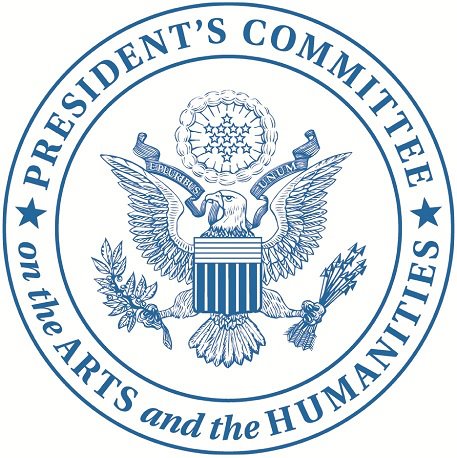 heard about it on Entertainment Tonight between cosmetic secrets of the stars at the Metropolitan Gala and celeb sightings of Blake Lively with Ryan Reynolds (Wedding plans in the works? You didn't hear it from me...).
If you are still curious about the Turnaround Arts Initiative, then this post will provide you with a tidy summary of the program from a policy and arts education perspective. Unfortunately though, this post does not include details on Eva Longoria’s summer workout plan and how-to advice on beating the heat in Mila Kunis-esque summer dresses. Sorry.
heard about it on Entertainment Tonight between cosmetic secrets of the stars at the Metropolitan Gala and celeb sightings of Blake Lively with Ryan Reynolds (Wedding plans in the works? You didn't hear it from me...).
If you are still curious about the Turnaround Arts Initiative, then this post will provide you with a tidy summary of the program from a policy and arts education perspective. Unfortunately though, this post does not include details on Eva Longoria’s summer workout plan and how-to advice on beating the heat in Mila Kunis-esque summer dresses. Sorry.
“We are, as a country, engaged in a national conversation about how to fix our nation’s broken schools. We feel strongly that, while no one strategy alone is a silver bullet, art education should have a seat at the table. Turnaround Arts will test that theory, in addition to bringing effective arts education to thousands of our neediest young people and creating more access to the arts in our most underserved neighborhoods.”
The Turnaround Arts Initiative is:
• an arts education funding initiative in full swing as of April 23, 2012
• a public-private partnership designed to help narrow the achievement gap and increase student engagement through the arts (private partners include: the Ford Foundation, the Herb Alpert Foundation, Crayola, the NAMM Foundation, the Aspen Institute and Booz Allen Hamilton)
• a creation of the President’s Committee on the Arts and Humanities (PCAH), in coordination with the U.S. Department of Education and the White House Domestic Policy Council (other public partners include the National Endowment for the Arts, the Arts Education Partnership, the Council of Chief State School Officers, and the National Assembly of State Arts Agencies)
• testing the hypothesis put forward by the PCAH’s 2011 report Reinvesting in Arts Education: Winning America’s Future Through Creative Schools, that “high-quality and integrated arts education can be an effective tool to strengthen school reform efforts-boosting academic achievement and increasing student motivation in schools facing some of the toughest educational challenges in the country”
• directed at the nation’s lowest-performing elementary and middle schools across the country, known as “turnaround schools” (turnaround schools are in the lowest-performing 5 percent of their state and receive School Improvement Grants through the Department of Education)
• a pilot project at this point, schools have already been selected to participate
• a two-year project, results will be evaluated at that point, program expansion will be considered, and resources will be made available from which ALL schools can benefit
What will the Turnaround Arts Initiative do and how will it be evaluated?
• Provide the selected schools with arts education services, resources and materials to “increase the likelihood of successful school turnaround, engage their community, and raise the visibility of their achievements”
• The key to the program's success is fully integrating the resources into the curriculum, making effective, impactful and rigorous arts programming part of the school’s being
• The impact and effectiveness of arts education in advancing academic achievement, student and community engagement, and overall school performance will be evaluated and reported by Booz Allen Hamilton, a consulting firm, at the close of the two-year term
Why did Entertainment Tonight cover the Turnaround Arts Initiative? Eight under performing schools across the country were selected through an application process. These schools have each been “adopted” by celebrity artists who will remain involved in the school’s curriculum reform by participating in events, performances, and classes. Below is the breakdown of each parent artist and their adopted school(s):
• Chuck Close (award-winning visual artist), Roosevelt Elementary in Bridgeport, Connecticut
• Yo-Yo Ma (award-winning cellist), Orchard Gardens School in Boston, Massachusetts
• Sarah Jessica Parker (award-winning actress), Martin Luther King, Jr. School in Portland, Oregon
• Kerry Washington (award-winning actress), Savoy Elementary in Washington, DC
• Forest Whitaker (award-winning actor), Findley Elementary School in Des Moines, Iowa
• Damien Woetzel (arts leader, previous Principle Dancer with New York City Ballet), Lame Deer Jr. High School in Lame Deer, Montana and Orchard Gardens Schools in Boston, Massachusetts
• Alfre Woodard (award-winning actress), Batiste Cultural Arts Academy in New Orleans, Louisiana and Noel Community Arts School in Denver, Colorado
Is there opposition?
• Diane Ravitch, author and previous U.S. Assistant Secretary of Education under George H. W. Bush and Bill Clinton, says the Turnaround Arts Initiative is just a “teeny, tiny little band-aid on what is a giant, national, festering problem…And it doesn’t begin to address the needs of the schools.”
But we have to start somewhere, right? Many school systems and communities are eager to be included in the program as it offers promising opportunities and resources customized to fit the needs of each school. However, as a pilot project with strict parameters, the Turnaround Arts Initiative is currently focused on evaluating the impact and results of the program on the eight selected schools over the next two years. Meanwhile, schools and the general public can stay informed about the project, its progress, and resources made available by referring to the Turnaround Arts Initiative website, its Twitter feed, and the Arts Education Partnership’s webpage.
Stay informed about the Initiative, stay inspired by its intentions, and keep advocating for arts education funding on a local level.
The Google Art Project and Art.sy: Exploration Engines for Art
The complexity and depth of the world’s art and culture is incredible and incredibly incomprehensible. Incredible because it evades definition and is relentlessly dynamic. Incomprehensible because the individual knowledge, time, and resources required to explore this cultural infinity are all too finite. Thus in this ever expanding universe, it is all too easy to gravitate towards the black hole of ignorance. But fear not, recent developments in technology are here to help steer us away from that ill-fated course. The upgrade of the Google Art Project and the launch of Art.sy are helping us understand our cultural universe, one art work at a time. With Google’s integrated documentation of the world’s museums, our artistic past is both nearer and clearer (literally, with a 7 billion pixel Rembrandt!). And Art.sy’s role as a “dynamic inventory” of emerging artists is an opportunity to discover contemporary art without being at the center of the artistic universe (New York or London).
The second phase of the Google Art Project has seen a massive expansion in the number of museums available on view. “Since last year, the Art Project has expanded its reach: 151 museums are now partners (compared to 17 in V1) providing over 30,000 artworks, from 40 countries (compared to 9 countries last year).”
From the National Gallery of Modern Art in New Delhi to the Getty Museum in Los Angeles, a visitor can experience a significant portion of the world as seen through objects, artifacts, paintings, and sculptures. Its new features include the ability to create your own collections and place them in personal “galleries”. The site also includes an entire section on ways to educate and be educated! For the initiated visitor, it is an invaluable opportunity for art historical exploration!
In its broader implications, the Art Project is a window into national identities as created through heritage and can be viewed as a vehicle for cultural diplomacy. This notion may seem overly ambitious, given the sites’ hyper-virtual immersion in a country’s artistic wealth and apparent disregard of chronology. But it exists nonetheless, as a weaker current that may invoke some to pursue additional research, and even create travel plans!
Additionally, the countries represented benefit from showcasing the wealth of their museum’s collections on an integrated domain, alongside world-renowned museums such as the Met. In essence, the Google Art Project acts as a virtual art fair for the world’s museums. It can either be surveyed at a harried pace or explored with deliberation. Either way, you get to collect works and create galleries for no cost at all!
In a similar vein to the Google Art Project, Art.sy is helping the world discover contemporary art, a category that often transcends national boundaries and is increasingly difficult to keep up with, let alone understand! With Art.sy the difficulties of “discovering fine art” are eased with the development of the Art Genome Project, “an ongoing study of the characteristics that distinguish and connect works of art.”
The website recently launched its beta version and some of its remarkable features were highlighted by the lucky few who were given access. Essentially, Art.sy allows users to discover new artists and works based on a set of 800 characteristics or genes that are assigned to each work of art. Given a user’s interest in a work of art and the underlying genes that are encompassed within, it suggests additional work that may interest them. Users can also choose to follow an artist or a gallery and of course, contact the gallery if they are interested in making a purchase.
A review by BetaBeat praised the site for its ability to lead an average art appreciator “to artists like Sherin Guirguis, a young Egyptian artist whose abstract paintings resemble fractals and eyeballs.” At the same time, it was criticized for only having secured partnerships with the leading galleries of the world and effectively limiting the art on view. Art.sy also retains an air of exclusivity, one that it may carry with it into the future.
Nevertheless, it would be remiss not to give the unique and brilliant workings of Art.sy a try.
In effect, both Art.sy and the Google Art Project are innovative discovery engines for art. The differentiation lies in that the former knows where you are headed even as you might not. The latter, in contrast, lets you meander your way to a destination unknown, an artwork unseen.





